Gymnopilus dilepis (Berk. & Broome) Singer - Magenta Rustgill
Phylum: Basidiomycota - Class: Agaricomycetes - Order: Agaricales - Family: Strophariaceae
Distribution - Taxonomic History - Etymology - Toxicity - Identification - Reference Sources
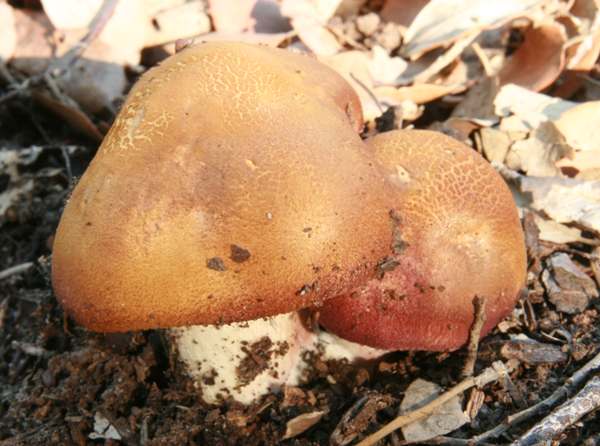
Growing on stumps or on dead conifer wood, most particularly of pine trees, buried in the litter of the forest floor, this beautiful mushroom is not easily confused with most other members of its genus because nearly all of them have orange caps.
Distribution
The Magenta Rustgill is a rare find in Britain, where formal records are concentrated in southern England, mainly in the south east, but it is also known to occur in East Anglia.
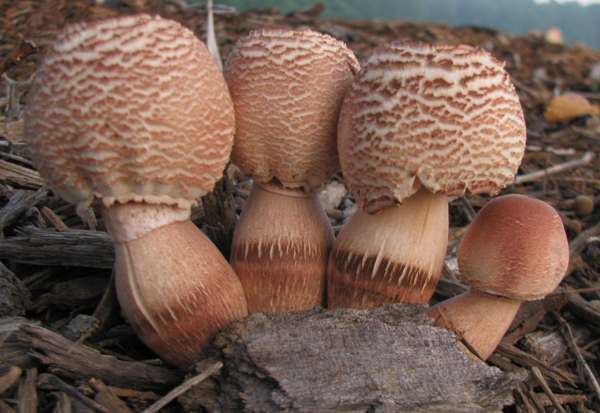
The Magenta Rustgill is much more common in southern Europe, and it is also recorded in many parts of North America as well as India and Australia. This mushroom is native to Southeast Asia, from where it has spread to many other parts of the world.
Taxonomic history
This mushroom was described in 1871 by British mycologists Miles Joseph Berkeley and Christopher Edmund Broome (1812 - 1866), when the Magenta Rustgill was given the scientific name Agaricus dilepis. It was German-American mycologist Rolf Singer who, in a 1951 publication, transferred this species to its present genus and thereby established its currently-accepted scientific name Gymnopilus dilepis.
Synonyms of Gymnopilus dilepis include Agaricus dilepis Berk. & Broome, Flammula dilepis (Berk. & Broome) Sacc., and Naucoria dilepis (Berk. & Broome) Cout.
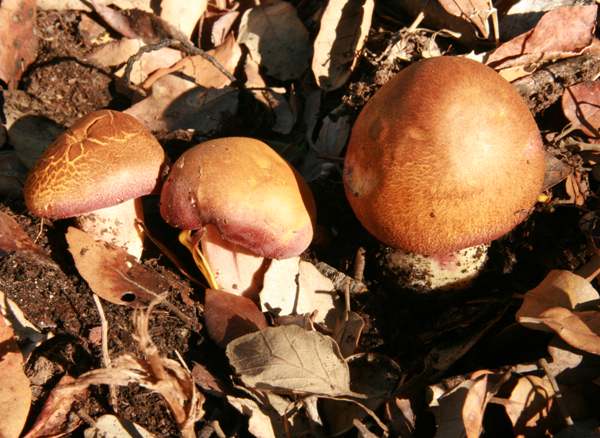
Etymology
Gymnopilus was proposed as a new genus name in 1879 by the Finnish mycologist Petter Adolf Karsten (1834 - 1917). The origin of this generic name is the prefix Gymn- meaning naked, and the suffix -pilus which means cap - hence naked or bald caps would normally be an expected feature of the mushrooms in this genus.
The specific epithet dilepis means 'with two scales' or perhaps 'with scales in pairs'. The origin is unclear to me except, of course, that this is indeed a scaly-capped mushroom.
Toxicity
The Magenta Rustgill is inedible and may even be poisonous; certainly some Gymnopilus fungi have been found to contain seriously poisonous chemicals.
Identification guide
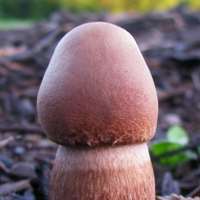 |
Cap4 to 8cm across; becoming almost flat but usually retaining a broad central umbo; felted when young, usually (but not always) breaking up into scales and sometimes cracking; purple becoming more orange-brown when old. |
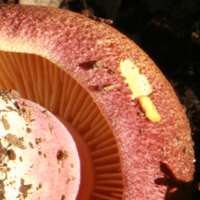 |
GillsAdnate; crowded; yellow, turning yellowish-brown when the spores mature. Stem4 to 8cm long and 1 to 2cm in dia., more or less cylindrical; smooth, with fine longitudinal fibres; yellowish flushed with cap colour; a fragile, sometimes ephemeral stem ring that becomes stained with spores at maturity. |
SporesEllipsoidal, warty, 6.5-8 x 4.5-5µm. Spore printYellowish brown. |
|
Odour/taste |
Not distinctive. |
Habitat & Ecological role |
Saprobic, on stumps, buried fallen branches and chipped wood of coniferous trees, especially pines. |
Season |
Autumn in Britain; October through to the New Year in Mediterranean countries. |
Similar species |
Tricholomopsis rutilans is very similar in appearance but has no stem ring; its spores are white. |
Reference Sources
Pat O'Reilly (2016).
Lincoff, G. and D. J. Mitchel. (1977). Toxic and Hallucinogenic Mushroom Poisoning. Van Nostrand Reinhold, New York.
Bresinsky A, Besl H. (1990). A Colour Atlas of Poisonous Fungi. Wolfe Publishing. ISBN 0-7234-1576-5.
Dictionary of the Fungi; Paul M. Kirk, Paul F. Cannon, David W. Minter and J. A. Stalpers; CABI, 2008
Taxonomic history and synonym information on these pages is drawn from many sources but in particular from the British Mycological Society's GB Checklist of Fungi.
Acknowledgements
This page includes pictures kindly contributed by Doug Holland.
Fascinated by Fungi. Back by popular demand, Pat O'Reilly's best-selling 450-page hardback book is available now. The latest second edition was republished with a sparkling new cover design in September 2022 by Coch-y-Bonddu Books. Full details and copies are available from the publisher's online bookshop...

